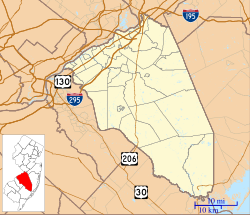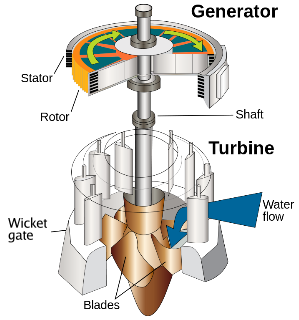
Delta, Ontario, is a community in the Township of Rideau Lakes, Leeds and Grenville County in Eastern Ontario. The village is located between two lakes, Upper Beverley and Lower Beverley, along highway 42, approximately 15 kilometers west of Athens, Ontario and 28 kilometers east of Westport, Ontario.

Brayton Grist Mill is an historic grist mill along Mashamoquet Brook, at the entrance to Mashamoquet Brook State Park off United States Route 44 in Pomfret, Connecticut. Built about 1890, it is one of the best-preserved 19th-century rural grist mills in the state. It was listed on the National Register of Historic Places in 1986. The mill has been restored, and is maintained by the Pomfret Historical Society as the Marcy Blacksmith Museum; it is open by appointment.
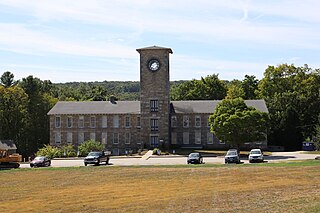
The Mansfield Hollow Historic District encompasses the remnants of a modest 19th-century industrial village on Mansfield Hollow Road in Mansfield, Connecticut. Originally industrialized with saw and grist mills, a silk mill was added in 1838, when it its most significant growth began. The surviving stone mill was built in 1882, and there are a number of nearby houses dating to the industrial period. The district was listed on the National Register of Historic Places in 1979.

Busti Mill, also known as the Old Mill, is a historic grist mill located at Busti in Chautauqua County, New York, USA. It was built in 1839 and remained in operation until around 1959 or 1960. In the later years, the mill was rented out and used sporadically, and the exact closing date is undetermined. The town of Busti deeded the mill to the Busti Historical Society on December 29, 1972.

The Newlin Mill Complex, also referred to as The Newlin Grist Mill, is a water powered gristmill on the west branch of Chester Creek near Concordville, Pennsylvania was built in 1704 by Nathaniel and Mary Newlin and operated commercially until 1941. During its three centuries of operation, the mill has been known as the Lower Mill, the Markham Mill, the Seventeen-O-Four Mill and the Concord Flour Mill. In 1958 the mill property was bought by E. Mortimer Newlin, restored and given to the Nicholas Newlin Foundation to use as a historical park. Water power is still used to grind corn meal which is sold on site. The park includes five historical buildings, which were added to the National Register of Historic Places in 1983, and 150 acres (61 ha) of natural woodland.

Mortonville is an unincorporated area and historic hamlet in Chester County, Pennsylvania on the eastern bank of the West Branch Brandywine Creek. It consists of about a half-dozen structures, two of which are on the National Register of Historic Places: the Mortonville Hotel, and the 12.5-foot-long (3.8 m) "Bridge in East Fallowfield Township" which crosses a mill race a few feet east of a larger bridge. The larger bridge, known as the Mortonville Bridge, was also listed on the NRHP until 2010 when it was delisted following a renovation. The two bridges are in East Fallowfield Township, while most other structures are in Newlin Township.
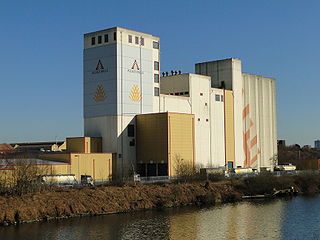
A gristmill grinds cereal grain into flour and middlings. The term can refer to both the grinding mechanism and the building that holds it.

Haines Mill, also known as Haines Mill Museum, is a historic grist mill located at South Whitehall Township, Lehigh County, Pennsylvania. It was built about 1840, and is a four-story, stone building with a slate covered gambrel roof. It is three bay by three bay, 42 feet by 46 feet, 9 inches. The interior was rebuilt after a disastrous fire in 1908. A three-story brick addition was built in 1930, with a lean-to roof. Atop the main roof is a cupola. It remained in full operation until 1957. Today, Haines Mill is operated as a partnership between the County of Lehigh, which owns and maintains the site, and the Lehigh County Historical Society, which provides public tours.

The Gooseville Mill/Grist Mill is a historic mill on the North Branch Milwaukee River in Gooseville, Wisconsin. The mill was built in 1879 to replace an 1855 mill that had burned down. The mill is a small custom mill with board and batten siding and is typical of the custom mills common in Sheboygan County in the 1800s. A Lefel turbine powered the mill, replacing the paddle wheel used in the 1855 mill. A burr mill was used to grind the grain processed at the mill. As of 1984, the mill was still operational and occasionally used as a sawmill.

Jervis Gordon Grist Mill Historic District, also known as Milford Grist Mill and Rowe's Mill, is a historic grist mill and national historic district located at Milford, Pike County, Pennsylvania. The district includes three contributing buildings and one contributing structure. The buildings are a late-19th century grist mill, blacksmith complex, and millers house. The contributing structure consists of the mill pond, dam, head race, and tail race.

Benson Grist Mill is a restoration-replica museum located in Tooele County, Utah in the western United States, which allows visitors to see the inner workings of a latter-nineteenth-century pioneer gristmill. It has four other historic (nineteenth-century) buildings which have been moved onto the site, as well as four ancillary structures, including an open-air pavilion. It covers 6.98 acres along State Highway 138, 0.8 mile southwest of the intersection of the Road with State Highway 36. The museum is owned and operated by a division of Tooele County.
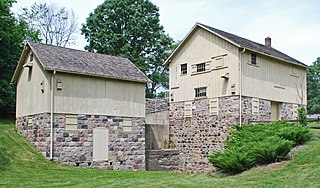
The Parker Mill, also known as Parker Mill Park or Parker Mill Complex, is a mill located at 4650 Geddes Road, east of Ann Arbor, Michigan. The mill is a well-preserved example of a small-scale grist mill operation that was once common in Michigan. The mill and nearby Parker House were listed on the National Register of Historic Places in 1982.

Senn's Grist Mill-Blacksmith Shop-Orange Crush Bottling Plant is a complex of historic commercial buildings located at Summerton, Clarendon County, South Carolina. The complex consists of three interconnected early-20th century buildings of similar size and construction. The grist mill was built about 1905, is an example of small independent grist mills that were commonplace in rural communities across the South. The blacksmith shop and bottling plant, built about 1921, are typical of early-20th century light industrial buildings. The complex supplied the local agricultural sector with essential goods and services for nearly a century.

Dorn's Flour and Grist Mill is a historic grist mill located at McCormick in McCormick County, South Carolina. It was built circa 1898 and is a 2 1/2- story, red brick structure with projecting one-story wings. A three-story brick wall of cross-shaped plan was built in 1915 to support a water tower tank. The mill originally housed a cotton gin. In the 1920s, grist mill equipment was added. The mill closed in the 1940s.
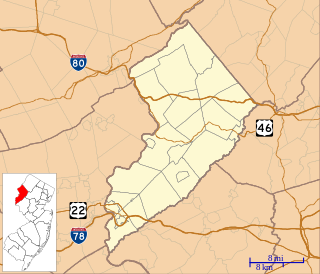
Warrington is an unincorporated community located within Knowlton Township in Warren County, New Jersey, United States.

The Somerset Roller Mills, also known as the Jacobs Creek Grist Mill, are a small former gristmill complex, originally built in the early 18th century, in Titusville, New Jersey.
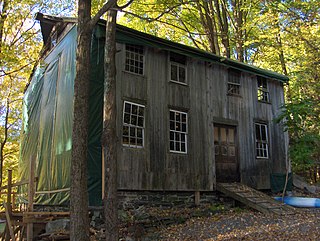
Gillette's Grist Mill is a historic grist mill on Maple Hollow Road in New Hartford, Connecticut. Probably built in the mid-19th century, it is an extremely rare example of a grist mill with a surviving water wheel. The mill property was added to the National Register of Historic Places in 1977.
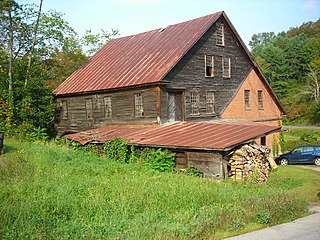
The Hayward and Kibby Mill, also known as the Tunbridge Mill, is a historic industrial facility on Spring Road in Tunbridge, Vermont. It includes a substantially complete water-powered 19th-century grist mill dating back to 1820, with a later sawmill added about 1870. It is one of the few surviving water-powered mills in the state, and is believed to be the only one featuring both a sawmill and grist (grain) mill. It was listed on the National Register of Historic Places in 1992.




